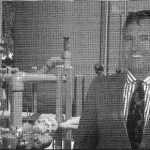Automatic Savings, Civil Engineering Magazine
System Design
Like the automobile, environmental treatment systems have changed dramatically in the past decade. In the past, automobiles required frequent maintenance, but this maintenance could be performed by mechanics with ordinary training. Now, because automobiles include computer technology, only highly trained electronics technicians can perform tune-ups.
Similarly, environmental treatment systems once required significant labor that was not highly specialized. Modern computerized control systems allow unmanned treatment processes to operate for longer periods without attention, except for routine maintenance analogous to changing the oil filter in a car. When more sophisticated, less frequent corrective maintenance is required, highly trained technicians equipped with modem diagnostic tools are needed.
Newly developed procedures and technology can continue to save money for site owners well into the O&M phase of long-term environmental projects. Owners can take advantage of highly automated treatment systems that combine environmental engineering expertise with the latest computer science technology.
The latest generation of digital field devices can gather, transmit and display information beyond simple process variable measurement. For example, they can monitor operational status and the readiness of the operating equipment. With this information, maintenance staff can perform preventive and corrective repairs in far less time and at far less cost than required by traditional, pre-digital control systems.
The most flexible control systems are industrial computer based and run Microsoft Windows software on an Intel Pentium personal computer. Standard control components, such as General Electric Fanuc programmable logic controllers (PLCs) and the InTouch Man-Machine Interface software from Wonderware Corp., Irvine, Calif., make these systems relatively inexpensive to install and maintain. An automated control system for a typical $1 million groundwater treatment plant costs about $20,000.
Digital field devices typically communicate with the PLC through a single communication cable. Gone is the need for an electrical engineer to prepare complicated drawings and wiring diagrams for installation and maintenance. Capital costs associated with plant engineering and construction drop dramatically.
A supervisory control and data acquisition (SCADA) system combines telemetry and computer technology to provide centralized monitoring and control of facilities over a large geographic area. By integrating a wide area network (WAN) and the Internet with the SCADA system, technicians can monitor and adjust a system anywhere in the world, from any location.
Once SCADA systems are installed, plants and systems can be remotely monitored and controlled – allowing troubleshooting, system resets and diagnostic work without a site visit. The customer’s local area network (LAN) can be integrated into a SCADA system to allow remote control from any workstation in the company. System security is designed to allow only the level of access that certain persons need.
Although construction cost savings generally pay for a distributed control system in a new treatment plant, O&M savings also make retrofit of existing systems an attractive option. Many site owners have discovered that reduced maintenance labor, downtime, repair costs and monitoring, as well as compliance improvements, result in a payback period of a few months.
Cost reduction is not the only reason to automate monitoring systems. Improved regulatory compliance may be reason enough. It is now possible to place environmental monitoring and control at the engineer’s desktop computer instead of in the plant’s control room. In fact, many systems are located at remote, unmanned sites and are designed using only a standard electrical cabinet to house the field components, such as a PLC. In these cases, complete operational control and monitoring of sites can be accomplished anywhere in the world from any location.
The most compelling benefit of automated control systems is that they provide an opportunity to shut down the treatment system early. All groundwater and soil vapor extraction systems approach the cleanup goal asymptotically, or with a greater reduction in contaminant levels early in the process. The high efficiency and reliability of automated systems mean that they achieve cleanup more rapidly than other systems, thus providing an opportunity to shut them down early.



